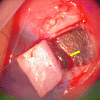Effect of Trabeculodescemetic Window Perforation in Deep Sclerectomy on Intraocular Pressure in Primary Congenital Glaucoma
- PMID: 38180630
- PMCID: PMC10787730
- DOI: 10.1007/s40123-023-00869-9
Effect of Trabeculodescemetic Window Perforation in Deep Sclerectomy on Intraocular Pressure in Primary Congenital Glaucoma
Abstract
Introduction: Primary congenital glaucoma causes vision loss if intraocular pressure is uncontrolled. Nonpenetrating deep sclerectomy is effective in treating primary congenital glaucoma. However, the effects of inadvertent trabeculodescemetic window perforation remain unclear.
Methods: This retrospective cohort study included patients with primary congenital glaucoma who underwent nonpenetrating deep sclerectomy between 2014 and 2021. The perforation group had intraoperative trabeculodescemetic window perforations; the non-perforation group did not. The primary outcome was intraocular pressure between the groups over 15 months. The secondary outcomes included surgical success and complications.
Results: The study included 74 eyes of 44 patients. The cohort comprised 31 perforated and 43 non-perforated eyes. Both groups showed significant intraocular pressure reduction without significant between-group differences in complete (68 vs. 77%), qualified (19 vs. 9%), or failed (13 vs. 14%) treatments. The median intraocular pressure decreased from 39 to 14 mmHg in the perforation group and 35 to 12 mmHg in the non-perforation group. Of the 74 treated eyes, 68 (92%) showed no complications.
Conclusions: An inadvertent trabeculodescemetic window perforation during nonpenetrating deep sclerectomy for primary congenital glaucoma did not significantly affect intraocular pressure outcomes compared to non-perforated cases over 15 months. Nonpenetrating deep sclerectomy reduced intraocular pressure regardless of intraoperative perforation in patients with primary congenital glaucoma. Perforation of the trabeculodescemetic window was associated with a low incidence of postoperative complications.
Keywords: Intraocular pressure; Nonpenetrating deep sclerectomy; Perforation; Primary congenital glaucoma; Trabeculodescemetic window.
© 2024. The Author(s).
Conflict of interest statement
Abdulaziz AlQattan, Konrad Schargel, Ibrahim AlJadaan, Nouf AlZendi, and Gorka Sesma declare that they have no competing interests.
Figures




Similar articles
-
Risk profile of deep sclerectomy for treatment of refractory congenital glaucomas.Ophthalmology. 2002 Jun;109(6):1066-71. doi: 10.1016/s0161-6420(02)01077-1. Ophthalmology. 2002. PMID: 12045045
-
Efficacy and safety of deep sclerectomy in childhood glaucoma in Saudi Arabia.Acta Ophthalmol. 2014 Feb;92(1):65-70. doi: 10.1111/j.1755-3768.2012.02558.x. Epub 2012 Dec 15. Acta Ophthalmol. 2014. PMID: 23241279
-
Non-Penetrating Deep Sclerectomy versus Trabeculectomy in Primary Congenital Glaucoma.Clin Ophthalmol. 2020 May 12;14:1277-1285. doi: 10.2147/OPTH.S253689. eCollection 2020. Clin Ophthalmol. 2020. PMID: 32494118 Free PMC article.
-
Anterior Segment Optical Coherence Tomography Imaging of Filtering Blebs after Deep Sclerectomy with Esnoper-Clip Implant: One-year Follow-up.J Curr Glaucoma Pract. 2014 Sep-Dec;8(3):91-5. doi: 10.5005/jp-journals-10008-1169. Epub 2015 Jan 15. J Curr Glaucoma Pract. 2014. PMID: 26997818 Free PMC article. Review.
-
[Non penetrating filtering surgery, evolution and results].J Fr Ophtalmol. 2002 May;25(5):527-36. J Fr Ophtalmol. 2002. PMID: 12048520 Review. French.
Cited by
-
Outcomes of Trabeculo-Descemet's Membrane Microperforation During Combined Phacoemulsification and Deep Sclerectomy.J Ophthalmic Vis Res. 2025 Jul 30;20:10.18502/jovr.v20.15249. doi: 10.18502/jovr.v20.15249. eCollection 2025. J Ophthalmic Vis Res. 2025. PMID: 40800626 Free PMC article.
References
LinkOut - more resources
Full Text Sources

